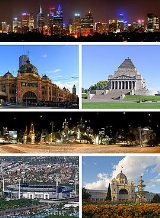
, and the second most populous city in Australia. The Melbourne City Centre
is the hub of the greater metropolitan area and the Census statistical division
—of which "Melbourne" is the common name. As of June 2009, the greater geographical area had an approximate population of four million. Inhabitants of Melbourne are called Melburnians.
The metropolis is located on the large natural bay known as Port Phillip
, with the city centre positioned at the estuary of the Yarra River
(at the northern-most point of the bay).
1892 The Limelight Department, one of the world's first film studios, is officially established in Melbourne, Australia.
1899 Leaders of six Australian colonies meet in Melbourne to discuss confederation.
1899 The Australian Premiers' Conference held in Melbourne decides to locate Australia's capital city, Canberra, between Sydney and Melbourne.
1899 The Australian Premiers' Conference held in Melbourne decides to locate Australia's capital city, Canberra, between Sydney and Melbourne.
1901 Australia opens its first parliament in Melbourne.
1913 Canberra Day: The future capital of Australia is officially named Canberra. (Melbourne remained temporary capital until 1927 while the new capital was still under construction.)
1934 The Shrine of Remembrance in Melbourne, Australia is opened.
1956 A violent water polo match between Hungary and the USSR takes place during the 1956 Summer Olympics in Melbourne, against the backdrop of the 1956 Hungarian Revolution.
1967 Ronald Ryan, the last person to be executed in Australia, is hanged in Pentridge Prison, Melbourne.
1970 Thirty-five construction workers are killed when a section of the new West Gate Bridge in Melbourne collapses.

